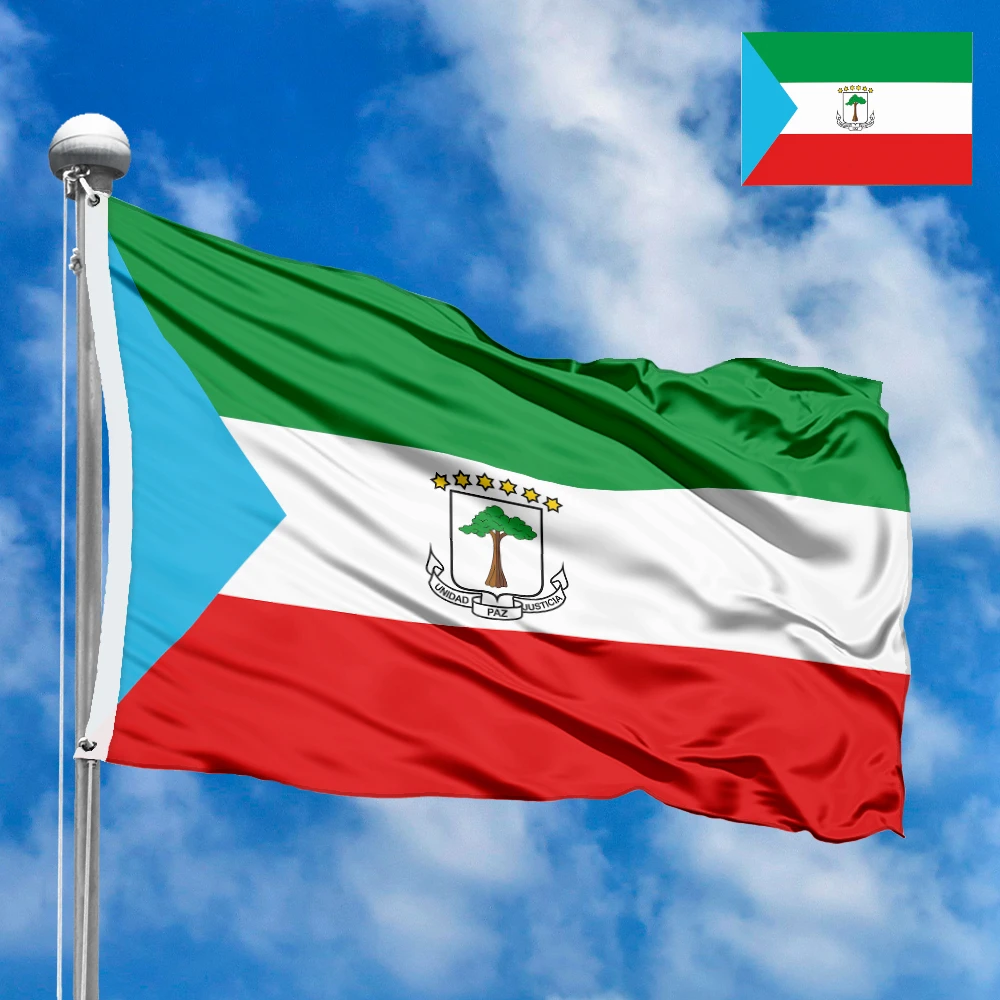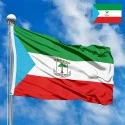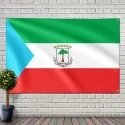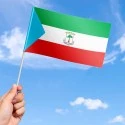The national flag of Equatorial Guinea is a vivid emblem, rich in color and symbolism, reflecting the nation's journey to independence, its natural wealth, and its core aspirations for its people. Adopted on October 12, 1968, the day of its independence from Spain, the flag has undergone a brief but significant alteration during a period of dictatorship, only to be fully restored to its original, meaningful design. It is a powerful representation of a country diverse in geography, culture, and history, united under a common banner. This comprehensive overview delves into the flag's intricate design, the profound meanings behind its colors and the national coat of arms, its historical evolution, its geographical context, and its deep significance for the citizens of Equatorial Guinea.
Design and Dimensions
The flag of Equatorial Guinea features a distinctive and easily recognizable layout that combines horizontal stripes with a prominent triangle and a central national emblem.
-
Overall Design: The flag consists of three equal horizontal stripes of green (top), white (middle), and red (bottom). A blue isosceles triangle is located on the hoist (left) side, with its base running along the full height of the flag and its apex pointing towards the center. Centered on the white stripe, directly in the middle of the flag, is the national coat of arms of Equatorial Guinea.
-
Dimensions: The official proportions for the flag are typically 2:3 (height to width). This ratio ensures that the various elements of the design, particularly the blue triangle and the coat of arms, are displayed harmoniously and in their intended scale.
-
Color Arrangement:
-
Green Stripe (Top): Represents the rich natural resources of the country, particularly its dense forests and jungles, which are a defining feature of the mainland region. It also symbolizes the agricultural potential and the vibrancy of the land.
-
White Stripe (Middle): Stands for peace, a fundamental aspiration for a nation that has endured colonial rule and periods of internal strife. It signifies purity and harmony.
-
Red Stripe (Bottom): Symbolizes the blood shed by the heroes and martyrs who fought for the country's independence and sovereignty. It is a solemn tribute to their sacrifices.
-
Blue Triangle (Hoist Side): This triangular shape represents the sea that connects the mainland territory of Río Muni to the country's various islands, including Bioko (where the capital Malabo is located), Annobón, Corisco, Elobey Grande, and Elobey Chico. It highlights the nation's maritime identity and the importance of its coastal and island territories.
Symbolism of the Colors and Elements
Every component of the Equatorial Guinean flag is deeply symbolic, telling a story of the nation's past, present, and future.
-
Green: As mentioned, green signifies the natural wealth of Equatorial Guinea, specifically its extensive forests, jungles, and agricultural lands. These resources are vital to the country's economy and identity, providing timber, fertile ground for crops, and rich biodiversity.
-
White: The white stripe represents peace and harmony. It expresses the profound desire of the people for a tranquil existence and a unified nation, free from conflict and discord.
-
Red: The red stripe serves as a poignant reminder of the sacrifices made and the blood shed by the patriots who fought for the nation's freedom and independence. It honors their courage and determination.
-
Blue Triangle: This element vividly symbolizes the Atlantic Ocean and the sea that surrounds Equatorial Guinea's islands and coastline. It represents the geographical connection between the mainland and the islands, which form an integral part of the nation. It also signifies the nation's maritime resources and its connection to the wider world.
-
The Coat of Arms: Positioned centrally on the white stripe, the national coat of arms is the most intricate and historically significant element.
-
The Ceiba Tree (Silk-Cotton Tree): The dominant feature of the shield is a majestic silk-cotton tree (scientifically Bombax ceiba), often referred to as the Ceiba tree. This tree holds immense historical significance: it is said to be the very tree under which the first treaty was signed between a local chief and the Spanish, marking the beginning of Spanish colonial rule. Thus, it symbolizes the historical roots of the nation and the place where its past was forged. It also represents the strength, endurance, and deep connection to the land.
-
Six Yellow Stars: Above the Ceiba tree, there are six yellow six-pointed stars arranged in an arc. These stars represent the five main islands that constitute part of Equatorial Guinea (Bioko, Annobón, Corisco, Elobey Grande, and Elobey Chico) and the mainland territory of Río Muni. They collectively symbolize the unity of all these distinct geographical parts under one nation.
-
Silver Shield: The Ceiba tree and stars are depicted on a silver (or grey) shield, a traditional heraldic element that signifies protection and strength.
-
Motto Scroll: Below the shield, a silver scroll proudly bears the national motto in Spanish: UNIDAD, PAZ, JUSTICIA (Unity, Peace, Justice). This motto encapsulates the core values and aspirations of the nation, emphasizing the importance of national cohesion, tranquility, and fairness in governance and society.
History of Creation and Adoption
The history of the Equatorial Guinean flag is closely tied to its colonial past and its struggle for self-determination, punctuated by a period of dictatorial rule.
-
Colonial Era (Pre-1968): Before its independence, Equatorial Guinea was a Spanish colony. The Spanish flag would have been flown officially, although local symbols might have been used informally by indigenous groups.
-
Independence and Initial Adoption (October 12, 1968): On the momentous day of its independence from Spain, October 12, 1968, the flag of Equatorial Guinea was officially adopted. This initial design included the green, white, and red stripes, the blue triangle, and the original coat of arms featuring the Ceiba tree and six stars with the motto "Unidad, Paz, Justicia." This flag was a symbol of newfound sovereignty and national pride.
-
The Macías Nguema Regime (1973-1979): The country's independence was soon marred by the brutal dictatorship of Francisco Macías Nguema. In 1973, under his regime, the coat of arms on the flag was removed and replaced with a different, more ideologically charged emblem. This new emblem featured a hoe and a sword crossed, symbolizing "revolutionary struggle" and the "sacrifice of the people." The national motto was also changed several times during this period, first to "Trabajo, Libertad, Justicia" (Work, Liberty, Justice), and later to "Unica Revolución" (One Revolution). This alteration of the national symbol reflected the totalitarian nature of the regime, seeking to erase historical ties and impose its own narrative.
-
Restoration of the Original Flag (August 21, 1979): The oppressive rule of Macías Nguema ended with a military coup led by Teodoro Obiang Nguema Mbasogo on August 3, 1979. Shortly thereafter, on August 21, 1979, the original flag, complete with its historically significant coat of arms featuring the Ceiba tree and the motto "Unidad, Paz, Justicia," was restored. This restoration symbolized a return to the nation's founding principles and a break from the tyranny of the previous regime. Since then, the flag has remained unchanged, serving as a continuous symbol of the nation's identity and its enduring values.
Country, Region, and Acceptance
Equatorial Guinea is a unique nation located in Central Africa. It is composed of a continental region, Río Muni, and several islands off the coast in the Gulf of Guinea, including Bioko (where the capital Malabo is located), Annobón, Corisco, and the two Elobey islands (Grande and Chico). It shares land borders with Cameroon to the north and Gabon to the east and south.
The flag of Equatorial Guinea is the official national symbol of the Republic of Equatorial Guinea. It is universally accepted by the government, all state institutions, the armed forces, and the vast majority of its citizens, both within the country and among the diaspora. It is prominently displayed at government buildings, embassies, schools, and during national celebrations, serving as a unifying emblem of the nation's sovereignty and collective identity.
Significance for the Inhabitants
For the people of Equatorial Guinea, the national flag holds profound and multi-layered significance, embodying their history, their sacrifices, and their hopes for the future:
-
Symbol of Hard-Won Independence: The flag, particularly its red stripe, is a constant reminder of the hard-won independence achieved after centuries of colonial rule. It honors the memory of those who fought and sacrificed for the nation's freedom, instilling a deep sense of gratitude and patriotism.
-
National Unity and Identity: With its diverse geography (mainland and islands) and various ethnic groups, the flag, especially through the six stars on its coat of arms, powerfully symbolizes national unity. It reminds citizens that, despite their geographical separation or ethnic differences, they are all part of one unified nation under the motto of "Unidad, Paz, Justicia." It reinforces a shared Equatorial Guinean identity.
-
Connection to Land and Sea: The green stripe and the blue triangle vividly represent the nation's fundamental connection to its natural environment. The green speaks of the rich forests and agricultural lands that sustain the people, while the blue highlights the vital role of the sea in connecting its scattered territories and providing resources.
-
Aspiration for Peace and Justice: The white stripe and the motto "Unidad, Paz, Justicia" articulate the nation's fundamental aspirations for peace, social harmony, and equitable governance. These ideals are particularly poignant given the country's past experiences with internal strife and authoritarian rule. The flag serves as a reminder of the values that should guide the nation's development.
-
Resilience and Restoration: The flag's history, with the brief removal and subsequent restoration of the coat of arms, also speaks to the resilience of the nation in overcoming periods of tyranny. It symbolizes the people's ability to reclaim their heritage and foundational values.
-
Source of Pride: For Equatorial Guineans, the flag is a potent source of national pride. Displaying or honoring the flag is an act of patriotism, celebrating their unique history, their natural beauty, and their status as a sovereign nation.
Interesting Facts
-
Only Spanish-Speaking African Nation: Equatorial Guinea is the only sovereign African country where Spanish is an official language (alongside French and Portuguese, though Spanish remains the most dominant). This is a legacy of its past as a Spanish colony.
-
Smallest Mainland African Nation: While not the smallest country in Africa (Seychelles, Sao Tome and Principe are smaller), Equatorial Guinea is one of the smallest countries on the African mainland by area, although a significant portion of its territory consists of islands.
-
Oil Wealth and Economic Growth: The discovery of large offshore oil reserves in the 1990s led to an unprecedented economic boom, making Equatorial Guinea one of the highest per capita income countries in Africa. However, this wealth has not been evenly distributed, leading to significant socio-economic challenges.
-
Island Capital: Unusually for an African nation, its capital city, Malabo, is not located on the mainland but on Bioko Island, an island of volcanic origin.
-
Pico Basilé: The highest peak in Equatorial Guinea, Pico Basilé, an extinct volcano, is also located on Bioko Island, reaching an elevation of 3,011 meters (9,878 feet).
-
Unique Biodiversity: Due to its diverse ecosystems, from dense rainforests on the mainland to volcanic islands, Equatorial Guinea boasts a rich and unique biodiversity, including rare species of primates and birds.
-
Annobón's Remote Culture: The island of Annobón, located far south of Bioko, has a distinct cultural identity due to its isolation. Its inhabitants speak a unique Portuguese-based Creole language (Fá d'Ambô) and have strong historical ties to São Tomé and Príncipe.
-
Planned Capital City (Oyala-Ciudad de la Paz): There is an ongoing project to build a new planned capital city, Oyala-Ciudad de la Paz (formerly Djibloho), on the mainland, intended to be a more accessible and central administrative hub for the nation.
-
Literacy Rate: Despite its oil wealth, the country faces challenges in development. The literacy rate, while improving, still reflects the need for further investment in education.
In the demonstration images, full-size flags are shown with proportions of 2:3, and hand-held flags with proportions of 1:2.






 Waving flag
Waving flag
 Sizes:
Sizes:
 Round flag
Round flag
 Sizes:
Sizes:
 Rectangular flag 2:3
Rectangular flag 2:3
 Sizes:
Sizes: